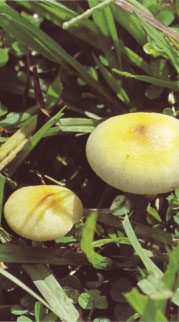- Strophariaceae - Cosmopolitan in the tropics
 |
Family: Agaricaceae: Strophariaceae; Stropharioideae Tribe, Cubensae Section
Genus: Psilocybe (Stropharia)
Species: cubensis
Common Names: di-ki-sho-lerraja, dishitjolerraja (Mazatec, "divine dung mushroom"), divine dung mushroom, golden top, gold top, hed keequai (Thai), hongo de San Isidro, hongo maravilloso, honguillos de San Isidro Labrador ("mushroom of Saint Isidro the Farmer" [= the saint of agriculture]), hysteria toadstool, kubanischer kahlkopf, magic mushroom, nocuana-be-neeche (Zapotec), nti-xi-tjolencha-ja (Mazatec, "mushroom like that which grows on cow patties"), San Isidro, San Isidro Labrador, tenkech (Chol), tenkech (Chol: Panlencano), zauberpilz
Psilocybe cubensis, or the "magic mushroom", is distinguished by its slightly curved cap, which features a yellow or golden center and can grow up to 8 cm in diameter. The only way to differentiate this mushroom from the very similar Psilocybe subcubensis is by the size of the cap (subcubensis caps do not grow to be quite as large).
Magic mushrooms contain on average about 0.6% psilocybin, although samples containing concentrations of up to 1% have been observed. The psychoactive components psilocin and baeocystin are also present in the mushroom, in average quantities of 0.15% and 0.02% respectively. The caps contain greater concentrations of psychoactive components than the stems.
It is the most commercially available of the Psilocybe mushrooms.
Though this fungus originated in Africa, it was first found in Cuba (cubensis = Cuban). As the mushroom only grows on cattle dung, it took the worldwide proliferation of African cattle before the mushroom began to grow in other continents; it now grows in tropical and subtropical areas far outside of Africa. It thrives in the heat and humidity characteristic of the tropics.
The magic mushroom is commonly offered in Bali and Thailand; in the latter country, omelets featuring this mushroom are popular. Additionally, an entire cottage industry of magic mushroom t-shirts has arisen there.
Terence McKenna posited the theory that Psilocybe cubensis is directly responsible for the origination of mankind; according to him, these mushrooms jump-started the evolution of our apelike ancestors into human beings. Self-awareness and an enhanced ability to survive and adapt (due to increased intelligence) were the fruits of this transformation. McKenna went on to say that not just various mushroom cults but also shamanism, mythology, and even more traditional religions all arose from Psilocybe cubensis experience.
TRADITIONAL USE: These mushrooms are used ritualistically in Mexico as well as central Europe. The shamanic use of Psilocybe cubensis was discovered during research into Psilocybe mexicana, the Mexican magic mushroom. In Mexico, Psilocybe cubensis is known as "hongo de San Isidro", ("mushroom of San Isidro"). It's no coincidence that to the Mazatec Indians, Saint Isidro is the patron saint of fields and meadows, as Psilocybe cubensis only grows in these areas. As cattle did not arrive in Mexico until the late colonial period, use of these mushrooms there could not have begun until then.
TRADITIONAL PREPARATION: The basic preparation for Psilocybe cubensis is very simple: pick and eat, or pick, dry, and then eat. Fresh mushrooms are most potent, but it is always better to wash them first, as they grow on dung. Fecal remnants are sometimes present on the mushroom after it is picked, as well as trace amounts of select toxins. It is also wise to avoid mushrooms that are rotting or have been partially eaten by insects.
While the stems do contain active components, these components are only barely present in the very bottom of the stem, which is also tough to consume. Therefore, it is best to cut it off.
To speed along the drying process, some heat can be applied, but too much will destroy the active components of the mushrooms.
For long-term storage, freezing in an airtight container is recommended. For short-term, the refrigerator works fine.
The mushrooms can be ingested on their own, or mixed with food additives just before consuming them, like chocolate, juice, or honey. In Thailand, fresh mushrooms are used like other mushrooms for culinary purposes, and dried mushrooms are smoked or baked in cookies with hemp.
Dosage varies based on the intended effect, but 3 - 5 grams is said to be an effective dose.
MEDICINAL USE: There are no known medicinal uses of Psilocybe cubensis.
TRADITIONAL EFFECTS: Like all mushrooms containing psilocybin, Psilocybe cubensis provides a potent visionary experience, often with shamanic qualities.
http://www.entheology.org/